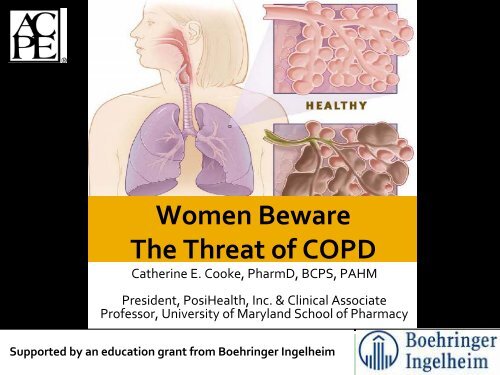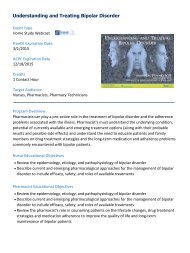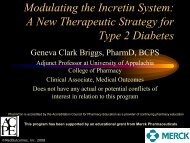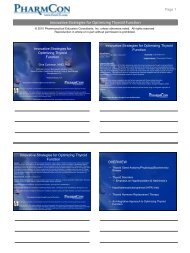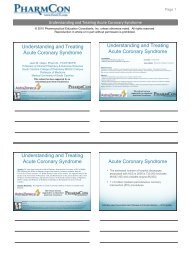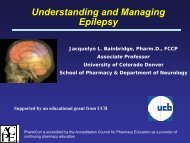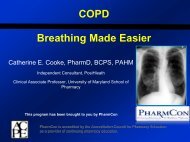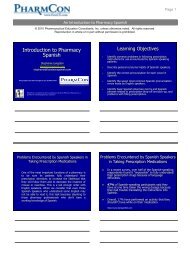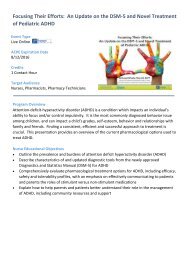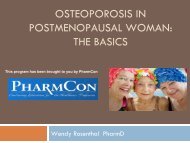COPD - Free CE Continuing Education online pharmacy, pharmacists
COPD - Free CE Continuing Education online pharmacy, pharmacists
COPD - Free CE Continuing Education online pharmacy, pharmacists
Create successful ePaper yourself
Turn your PDF publications into a flip-book with our unique Google optimized e-Paper software.
Women Beware<br />
The Threat of <strong>COPD</strong><br />
Catherine E. Cooke, PharmD, BCPS, PAHM<br />
President, PosiHealth, Inc. & Clinical Associate<br />
Professor, University of Maryland School of Pharmacy<br />
Supported by an education grant from Boehringer Ingelheim
Women Beware<br />
The Threat of <strong>COPD</strong><br />
Speaker: Catherine Cooke attained her Bachelor in Pharmacy from the University of Iowa and then<br />
went on to receive her Pharm.D. from the Medical University of South Carolina. Subsequently, she<br />
completed a specialty residency in Ambulatory Care/Managed Care through the Philadelphia College of<br />
Pharmacy and Science. After post-graduate training, Dr. Cooke served as a full-time Assistant<br />
Professor at the University of Maryland School of Pharmacy where she became a Board Certified<br />
Pharmacotherapy Specialist. Currently, she is an Independent Consultant working in health care quality<br />
and research. In addition, she provides clinical <strong>pharmacy</strong> services such as hypertension, dyslipidemia<br />
and smoking cessation management to patients in Maryland. Her main research interests are in the<br />
areas of cardiovascular pharmacotherapeutics and <strong>pharmacy</strong> services in the managed care<br />
environment with specific interest in discrepancies in health care based on sex or ethnicity.<br />
Speaker Disclosure: Dr. Cooke has no actual or potential conflicts of interest in relation to this program<br />
Supported by an education grant from Boehringer Ingelheim<br />
PharmCon is accredited by the Accreditation Council for Pharmacy <strong>Education</strong> as a provider of<br />
continuing <strong>pharmacy</strong> education
Women Beware<br />
The Threat of <strong>COPD</strong><br />
Accreditation:<br />
Pharmacists 798-000-09-028-L01-P<br />
Pharmacy Technicians 798-000-09-028-L01-T<br />
Target Audience: Pharmacists & Technicians<br />
<strong>CE</strong> Credits:<br />
1.0 <strong>Continuing</strong> <strong>Education</strong> Credit or 0.1 <strong>CE</strong>U for<br />
<strong>pharmacists</strong>/technicians<br />
Expiration Date: 05/27/2012<br />
Program Overview: Women have made a good deal of welcome progress in the last several decades, but at least one<br />
advance is unwanted: chronic obstructive pulmonary disease (<strong>COPD</strong>) is on the rise in women in prevalence, morbidity and<br />
mortality. By 2000, the number of women dying from <strong>COPD</strong> surpassed the number of men. But the rising number of cases in<br />
women has not been matched by medical understanding of the disease's apparent gender-bias. This program will increase<br />
the awareness of <strong>COPD</strong> in women. The program will focus on the <strong>pharmacists</strong> role in identifying patients with <strong>COPD</strong> (women<br />
in particular), reducing the risk factors for developing <strong>COPD</strong> (such as smoking cessation), and managing the disease.<br />
Objectives:<br />
•Review the etiology and epidemiology of chronic obstructive pulmonary disease (<strong>COPD</strong>) in women.<br />
•Identify the impact of <strong>COPD</strong> on women and the differences in how the disease manifests itself in women compared to men.<br />
•Provide an update on the efficacy, safety, and role of available treatments in the management of <strong>COPD</strong>.<br />
•Describe how pharmacist’s can play a critical role in <strong>COPD</strong> identification, management and education (particularly with<br />
women).<br />
Supported by an education grant from Boehringer Ingelheim<br />
PharmCon is accredited by the Accreditation Council for Pharmacy <strong>Education</strong> as a provider of continuing <strong>pharmacy</strong><br />
education
Learning Objectives<br />
• REVIEW the etiology and epidemiology of chronic<br />
obstructive pulmonary disease (<strong>COPD</strong>) in women.<br />
• IDENTIFY the impact of <strong>COPD</strong> on women and the<br />
differences in how the disease manifests itself in<br />
women compared to men.<br />
• PROVIDE an update on the efficacy, safety, and role<br />
of available treatments to manage <strong>COPD</strong>.<br />
• DESCRIBE how pharmacist’s can play a critical role<br />
in <strong>COPD</strong> identification, management and education<br />
(particularly with women).
Chronic obstructive pulmonary<br />
disease (<strong>COPD</strong>)<br />
• Characterized by airflow limitation<br />
• Not fully reversible<br />
• Usually progressive<br />
• Used to be looked upon as 2 diseases –chronic<br />
bronchitis and emphysema– but usually<br />
conditions coexist<br />
• Chronic bronchitis<br />
• Bronchial tubes are inflamed and eventually scarred<br />
• Emphysema<br />
• Alveoli are irreversibly damaged and lose elasticity<br />
1. Rennard SI. <strong>COPD</strong>: overview of definitions, epidemiology, and factors influencing its development. Chest 1998;113(Suppl 4):235‐‐41s.
<strong>COPD</strong><br />
Asthma<br />
Age of onset Usually >40 years Any age (usually<br />
< 40 years)<br />
Smoking History<br />
Symptom<br />
Pattern<br />
Airway<br />
Reversibility<br />
Steroid response<br />
in stable disease<br />
Usually > 20 packyears<br />
Usually chronic,<br />
slowly progressive<br />
Partially reversible<br />
Unusual (~15% ‐<br />
20%)<br />
Unrelated<br />
Varies day by day<br />
Nocturnal/early<br />
morning<br />
Largely reversible<br />
Present
Clinical Presentation of <strong>COPD</strong><br />
• Symptoms<br />
• Chronic cough<br />
• Sputum production<br />
• Shortness of breath leading to chronic fatigue, decreased<br />
exercise capacity and increased respiratory exacerbations<br />
• Consequences<br />
• Respiratory failure<br />
• Cor pulmonale (right sided heart failure)<br />
• Respiratory exacerbations become life‐threatening
Spirometry<br />
•Lung function reported as percent of<br />
predicted values for<br />
a normal population<br />
•Terminology<br />
• FEV 1 = forced expiratory volume in 1 second<br />
• FVC = forced vital capacity
<strong>COPD</strong> – Defining Characteristics<br />
Spirometric diagnostic criteria<br />
•Reduced forced expiratory volume in 1 second<br />
FEV 1 < 80%<br />
•Reduced ratio of FEV 1 to FVC<br />
FEV 1 /FVC < 70%
Spirometry: Volume/Time Curve<br />
FEV 1 FVC FEV 1 / FVC<br />
Normal 4.15<br />
5.2 > 80%<br />
<strong>COPD</strong><br />
2.35 3.9 < 70%<br />
1<br />
2<br />
FEV 1<br />
Liters<br />
3<br />
4<br />
FEV 1<br />
<strong>COPD</strong><br />
FVC<br />
5<br />
Normal<br />
FVC<br />
1 2 3 4 5 6<br />
Seconds
Diagnosis of <strong>COPD</strong> in Women<br />
80<br />
70<br />
60<br />
%<br />
Diagnosed<br />
50<br />
40<br />
30<br />
20<br />
10<br />
0<br />
Clinical presentation<br />
Female case<br />
Male case<br />
Spirometry
Diagnosis of <strong>COPD</strong> in Women<br />
• Spirometry<br />
• Primary care physicians underutilize spirometry<br />
• Women less likely to receive referrals to<br />
specialists than men<br />
• Study: Confronting <strong>COPD</strong> Survey<br />
• Women less likely to have spirometry than men<br />
(OR 0.84; 95% CI 0.72‐0.98)
• Estimated 24 million adults with <strong>COPD</strong> in US<br />
• <strong>COPD</strong> ‐ 4 th leading cause of death in the US 1<br />
• Hospitalization:<br />
• Hospitalization rates greater for women than men since 1993<br />
• Mortality –worse in women<br />
1. National Center for Health Statistics. Deaths: final data for 1999. Hyattsville, MD: U.S. Department of Health<br />
and Human Services, Centers for Disease Control and Prevention. National Vital Statistics Report 2001;49:1–<br />
116.<br />
2. American Lung Association Epidemiology and Statistics Unit Research and Program Services. Trends in<br />
<strong>COPD</strong>(Chronic Bronchitis and Emphysema); Morbidity and Mortality. American Lung Association Website.<br />
http://lungusa.org. Accessed march 14 th , 2009.
Number Deaths x 1000<br />
70<br />
60<br />
50<br />
40<br />
30<br />
20<br />
10<br />
0<br />
Men<br />
Women<br />
1980 1985 1990 1995 2000<br />
US Centers for Disease Control and Prevention, 2002
• Tobacco use is the #1 cause of <strong>COPD</strong> 1<br />
• 75% of deaths from <strong>COPD</strong> resulted from<br />
smoking in 2005<br />
• Cigarette smokers vs. nonsmokers 2<br />
• Greater annual decrease in FEV1<br />
• More respiratory symptoms<br />
• Higher death rates<br />
1. Centers for Disease Control and Prevention (CDC). Deaths from chronic obstructive pulmonary disease‐‐United States, 2000‐2005. [Journal Article]<br />
MMWR ‐ Morbidity & Mortality Weekly Report. 57(45):1229‐32, 2008 Nov 14.<br />
2. American Lung Association Epidemiology and Statistics Unit Research and Program Services. Trends in <strong>COPD</strong>(Chronic Bronchitis and Emphysema);<br />
Morbidity and Mortality. American Lung Association Website. http://lungusa.org. Accessed march 14 th , 2009.
Women more susceptible to smoke?<br />
• Meta‐analysis: Women who smoke had<br />
significantly faster annual decline in FEV1%<br />
predicted with increasing age vs. men who<br />
smoke<br />
• Lung Health Study<br />
• Increase in # of cigarettes resulted in larger<br />
decline in FEV1 than men<br />
• Why?
• Genetic – severe heredity deficiency of<br />
alpha‐1 antitrypsin<br />
• Occupational –dust and chemicals<br />
• Pollution – indoor (biomass cooking) and<br />
outdoor (urban pollution)<br />
• Infection– severe childhood respiratory<br />
infection<br />
• Women who smoke during pregnancy<br />
decrease lung growth in utero<br />
1. American Lung Association Epidemiology and Statistics Unit Research and Program Services. Trends in <strong>COPD</strong> (Chronic Bronchitis and Emphysema): Morbidity and Mortality. American Lung<br />
Association Website. http://lungusa.org. Accessed March 14 th , 2009.
GOLD –Global Initiative for<br />
Chronic Obstructive Lung<br />
Disease 1<br />
• US National Heart, Lung and<br />
Blood Institute and World Health<br />
Organization joint committee<br />
• First published in 2001<br />
• Last revision published 2008<br />
• Covers diagnosis, management<br />
and prevention<br />
• Does not differentiate diagnosis<br />
and management between men<br />
and women<br />
1. National Heart, Lung, and Blood Institute and World Health Organization. Global initiative for chronic obstructive lung disease: global strategy for diagnosis, management, and prevention of<br />
chronic obstructive pulmonary disease. 2008 update. Available at: www.goldcopd.com. Accessed March 15 th ,2009.
Treatment Pathway
I: Mild <strong>COPD</strong><br />
•FEV1/FVC < 70%<br />
•FEV1 >= 80% predicted<br />
II: Moderate <strong>COPD</strong><br />
•FEV1/FVC < 70%<br />
•50%
Non Pharmacologic<br />
Therapy
Smoking Cessation
Vaccines<br />
• Flu: Annual influenza vaccine<br />
• Pneumococcal polysaccharide vaccine<br />
▪ Age 65 or older<br />
▪
Pharmacotherapy
• Central to symptomatic management<br />
• PRN or scheduled based on severity<br />
• Inhaled route preferred – fewer adverse effects<br />
• Includes: β2‐ agonists, anticholinergics and<br />
methylxanthines<br />
• All increase exercise capacity<br />
• Long‐acting forms more effective and convenient
Medication<br />
Class<br />
Bronchodilator-<br />
Short acting B2-<br />
agonist<br />
Class Side<br />
Effects:<br />
dry mouth, irritated<br />
throat, trembling,<br />
nervousness,<br />
dizziness,<br />
headache,<br />
palpitations,<br />
nausea, vomiting<br />
Brand Generic Availability Dosage<br />
Form<br />
Proventil Albuterol Brand only Inhaler No -asthma,<br />
bronchitis<br />
FDA approval Directions<br />
2 inhalationsevery 4—6<br />
hours<br />
Ventolin Albuterol Brand only Inhaler No -asthma 2 inhalations every 4—6<br />
hours<br />
Proair Albuterol Brand only Inhaler No -asthma 2 inhalations every 4—6<br />
hours<br />
Xopenex levalbuterol Brand only Inhaler No - asthma 2 inhalations every 4—6<br />
hours<br />
Maxair Pirbuterol Brand only Inhaler Yes 2 inhalations every 4—6<br />
hours<br />
Brethine Terbutaline Generic only Tablets Yes, also asthma 5 mg PO three times daily<br />
Alupent Metaproterenol Generic only nebulizing<br />
solution<br />
Accuneb Albuterol solution Generic only nebulizing<br />
solution<br />
Yes 0.2—0.3 ml of 5% (10—15<br />
mg) solution, diluted in 2.5—<br />
3 ml of 1/2 NS, NS, or other<br />
diluents or, 2.5 ml of 0.4—<br />
0.6% solution (10—15 mg).<br />
Doses may be repeated 3—4<br />
times per day<br />
No -asthma,<br />
bronchitis<br />
2.5—5 mg initially every 20<br />
minutes for 3 doses, then<br />
2.5—10 mg every 1—4<br />
hours as needed<br />
1. Micromedex® Healthcare Series [intranet database]. Version 5.1. Greenwood Village, Colo: Thomson Healthcare. Available at: http://www.thomsonhc.com.ezproxy.samford.edu/<br />
home/dispatch. Accessed March 18 2009.
Medication<br />
Class<br />
Brand Generic Availability Dosage<br />
Form<br />
FDA<br />
approval<br />
Directions<br />
Bronchodilator-<br />
Long acting B2-<br />
agonist<br />
Foradil Formoterol Brand only Aerolizer Yes, also asthmaInhale 12 mcg (contents<br />
of one capsule) every 12<br />
hours using the Aerolizer<br />
Serevent Salmeterol Brand only Diskus Yes, also asthma50 mcg (1 oral inhalation)<br />
of salmeterol twice daily<br />
Class Side Effects:<br />
dry mouth, irritated<br />
throat, trembling, Perforomist Formoterol Brand only Nebulizing<br />
nervousness,<br />
solution<br />
dizziness,<br />
headache,<br />
palpitations,<br />
nausea, vomiting<br />
Yes, also asthmaOne 20 mcg unit dose<br />
vial administered by<br />
nebulization twice daily in<br />
the morning and evening<br />
1. Micromedex® Healthcare Series [intranet database]. Version 5.1. Greenwood Village, Colo: Thomson Healthcare. Available at: http://www.thomsonhc.com.ezproxy.samford.edu/<br />
home/dispatch. Accessed March 18 2009.
Medication<br />
Class<br />
Brand Generic Availability Dosage<br />
Form<br />
FDA<br />
approval<br />
Directions<br />
Anitcholinergics-<br />
Short and long<br />
acting<br />
Atrovent ipratropium Brand only Inhaler Yes, also asthma 2 sprays (18 mcg/spray)<br />
3—4 times per day<br />
Class Side<br />
Effects:<br />
Dry mouth, blurred<br />
vision,<br />
constipation, runny<br />
nose, irritated<br />
throat, runny nose,<br />
Spiriva tiotropium Brand only Handihaler Yes 18 mcg once per day via<br />
oral inhalation<br />
Ipitropiuim<br />
solution<br />
ipratropium Generic only Nebulizing<br />
solution<br />
Yes, also asthma 500 mcg (1 unit dose vial)<br />
3—4 times per day via<br />
oral nebulization<br />
1. Micromedex® Healthcare Series [intranet database]. Version 5.1. Greenwood Village, Colo: Thomson Healthcare. Available at: http://www.thomsonhc.com.ezproxy.samford.edu/<br />
home/dispatch. Accessed March 18 2009.
AntiCholinergics & CV Risk?<br />
• Meta‐Analysis to assess CV risks associated with >30 day use of<br />
ipratropium and tiotropium vs. control in patients with <strong>COPD</strong><br />
• 17 RCT with 7472 on anticholinergics and 7311 on control<br />
• Results:<br />
• Inhaled anticholinergics significantly increased:<br />
▪ Risk of CV death, non‐fatal MI or stroke, RR 1.58 (95% CI,<br />
1.21‐2.06)<br />
▪ MI, RR 1.53, (95% CI 1.05‐2.23)<br />
▪ CV death, RR 1.80 (95% CI 1.17‐2.77)<br />
• Stroke NOT significantly increased<br />
• Secondary outcome ‐ risk of all‐cause mortality NS difference<br />
• Need prospective RCT to accurately access CV risk
• Low dose theophylline reduces exacerbations but<br />
does not increase post‐bronchodilator lung function<br />
• Higher does are effective bronchodilators, but may<br />
cause toxicity<br />
• Theophylline Dosing<br />
• 150mg BID increase to 200mg BID after 3 days,<br />
• Then 300mg BID after 3 days or 300‐400 QD then 400‐<br />
600mg QD<br />
• Titrate according to blood level<br />
1. Micromedex® Healthcare Series [intranet database]. Version 5.1. Greenwood Village, Colo: Thomson Healthcare. Available at: http://www.thomsonhc.com.ezproxy.samford.edu/<br />
home/dispatch. Accessed March 18 2009.
Steroids<br />
• Regular treatment does not modify long term<br />
decline<br />
• Increases likelihood of pneumonia, does not<br />
decrease mortality<br />
• Reduce exacerbations in Severe <strong>COPD</strong> and Very<br />
Severe <strong>COPD</strong> FEV1
Inhaled Steroids<br />
Medication<br />
Class<br />
Brand Generic Availability Dosage<br />
Form<br />
FDA<br />
approval<br />
Directions<br />
Inhaled<br />
Corticosteroids<br />
Qvar beclomethasone Brand only Inhaler No - asthma 40—80 mcg (1—2 sprays)<br />
inhaled orally twice daily<br />
Pulmicort budesonide Brand only Flexhaler No - asthma 360 mcg twice daily by<br />
oral inhalation<br />
Pulmicort<br />
Respules<br />
budesonide Brand/Generic Nebulizing<br />
solution<br />
No - asthma For children: 0.5 mg/day<br />
inhaled via jet nebulizer<br />
either once daily or divided<br />
into 2 doses<br />
Flovent fluticasone Brand only Diskus Yes, also asthma 1 inhalation twice daily<br />
Class Side<br />
Effects:<br />
dry mouth,<br />
hoarseness,<br />
throat infection,<br />
oral candidiasis<br />
Alvesco Ciclesonide Brand only Inhaler No, asthma,<br />
allergies<br />
1 inhalation twice daily<br />
Asmanex Brand only Twisthaler No, asthma 1 inhalation twice dialy<br />
Azmacort triamcinolone Brand only Inhaler No - asthma Initially, 150 mcg (2<br />
inhalations) PO 3—4 times<br />
per day or 300 mcg (4<br />
inhalations) PO twice<br />
daily.<br />
Aerobid flunisolide Brand only Inhaler No- asthma 2 sprays (250 mcg/spray)<br />
via oral inhalation twice<br />
daily<br />
1. Micromedex® Healthcare Series [intranet database]. Version 5.1. Greenwood Village, Colo: Thomson Healthcare. Available at: http://www.thomsonhc.com.ezproxy.samford.edu/<br />
home/dispatch. Accessed March 18 2009.
Brand Generic Availability Dosage<br />
Form<br />
FDA approval<br />
Directions<br />
Combivent albuterol/ipratropium Brand only Inhaler Yes, also asthma Inhale 2 actuations four times<br />
per day<br />
Advair salmeterol/fluticasone Brand only Diskhaler Yes, also asthma 1 inhalation twice a day<br />
Duoneb albuterol/ipratropium Brand/generic Nebulizing<br />
solution<br />
Yes, also asthma<br />
Inhale one 3 ml vial via<br />
nebulizer four times per day<br />
Symbicort budesonide/formoterol Brand only Inhaler Yes, also asthma 2 inhalations of Symbicort<br />
160/4.5 (160 mcg of<br />
budesonide and 4.5 mcg of<br />
formoterol per inhalation) twice<br />
daily<br />
1. Micromedex® Healthcare Series [intranet database]. Version 5.1. Greenwood Village, Colo: Thomson Healthcare. Available at: http://www.thomsonhc.com.ezproxy.samford.edu/<br />
home/dispatch. Accessed March 18 2009.
• Inquire about and recommend spirometry<br />
• Smoking cessation counseling at every visit<br />
• Nutrition counseling<br />
• Preventing infections –hand washing, vaccinations<br />
• Recognizing exacerbations<br />
• <strong>Education</strong><br />
• Depression and anxiety screening<br />
• Support groups
• Training patients to use inhalers is crucial 1 :<br />
1. Mourad RE, Hagerman JK. Management Strategies in Stable <strong>COPD</strong>. US Pharmacist.2009;34‐HS‐10‐HS‐18. Jan 26 2009.
66 yo woman visits PCP for a lingering cough<br />
after having a cold<br />
Subjective:<br />
CC: “I’ve been recovering from a cold, but the cough is<br />
getting worse even though my nose is not running anymore.<br />
Sometimes the cough is so bad that it keeps me awake<br />
at night.“<br />
HPI: MF recovered from a cold 1 month ago, but still suffers<br />
from a cough with sputum. Patient has had a chronic cough<br />
since she quit smoking 5 years ago, but lately it is getting<br />
worse. Cough worsens with exercise and during the winter<br />
months.<br />
PMH: Tobacco dependence for 35 years, smoke‐free for 5<br />
years, HTN, Seasonal allergies
66 yo woman visits PCP for a lingering cough<br />
after having a cold<br />
Objective:<br />
Medications:<br />
• Amlodipine 10mg PO QAM<br />
• HCTZ 25 mg PO QAM<br />
• Nasonex 2 sprays in each nostril QD during allergy season<br />
• Claritin D PO QD during allergy season<br />
PE: General‐ Overweight female coughing with clear sputum.<br />
VS: BP138/85, P 110, RR 22, Wt 70kg, Ht 5’4’, T 37<br />
degrees, O2 sat 90%
66 yo woman visits PCP for a lingering cough<br />
after having a cold<br />
Diagnosis:<br />
• CXR ‐ Normal<br />
• Spirometry ‐ FEV1 = 0.65, FEV1/FVC= 76% (Referral to<br />
pulmonologist)<br />
Assessment:<br />
1) Undiagnosed Stage II moderate <strong>COPD</strong> ‐ uncontrolled<br />
2) HTN ‐ controlled<br />
3) Seasonal allergic rhinitis ‐ controlled
Stage II moderate <strong>COPD</strong> ‐ uncontrolled<br />
Plan:<br />
• Educate patient about disease and disease<br />
progression<br />
• Pharmacologic regimen:<br />
• Start short‐acting beta‐agonist inhaler PRN and<br />
tioptropium inhalation QD<br />
• <strong>Education</strong> patient on inhaler technique<br />
• Re‐evaluate in 1 month<br />
• Schedule for influenza (seasonal) and<br />
pneumococcal vaccinations
Conclusion<br />
• Improve diagnosis of <strong>COPD</strong> in women<br />
(increased suspicion, spirometry, referral to<br />
specialist)<br />
• <strong>Education</strong>: Prevention –Smoking<br />
• Women at higher risk<br />
• Management: Smoking cessation (with<br />
increased attention to preventing relapse)<br />
• Vaccines<br />
• Pharmacotherapy<br />
• Use therapies based on severity of <strong>COPD</strong>


